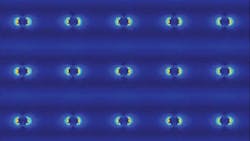Biocompatible nanolaser has ability to function inside living tissues
A team of researchers at Northwestern University (Evanston, IL) and Columbia University (New York, NY) has developed a nanolaser that can function inside of living tissues without harming them. Measuring 50–150 nm thick, the laser can fit and function inside living tissues, with the potential to sense disease biomarkers or perhaps treat deep-brain neurological disorders, such as epilepsy.
The nanolaser, mainly made of biocompatible glass, shows promise for imaging in living tissues. What's more, the laser can also be excited with longer wavelengths of light and emit at shorter wavelengths.
"Longer wavelengths of light are needed for bioimaging because they can penetrate farther into tissues than visible wavelength photons," says Teri Odom, the Charles E. and Emma H. Morrison Professor of Chemistry in Northwestern University's Weinberg College of Arts and Sciences, who co-led the research along with P. James Schuck, associate professor of mechanical engineering at Columbia University's School of Engineering. "But shorter wavelengths of light are often desirable at those same deep areas. We have designed an optically clean system that can effectively deliver visible laser light at penetration depths accessible to longer wavelengths."
Current nanolasers tend to be much less efficient than their macroscopic counterparts—and typically need shorter wavelengths, such as ultraviolet (UV) light, to power them. "This is bad because the unconventional environments in which people want to use small lasers are highly susceptible to damage from UV light and the excess heat generated by inefficient operation," says Schuck.
The researchers were able to achieve a nanolaser platform that solves these issues by using photon upconversion, in which low-energy photons are absorbed and converted into one photon with higher energy. In this project, the team started with low-energy, bio-friendly infrared photons and upconverted them to visible laser beams. The resulting laser can function under low powers and is vertically much smaller than the wavelength of light.
"Our nanolaser is transparent, but can generate visible photons when optically pumped with light our eyes cannot see," says Odom. "The continuous-wave, low-power characteristics will open numerous new applications, especially in biological imaging."
The nanolaser also can operate in extremely confined spaces, including quantum circuits and microprocessors for ultrafast and low-power electronics.
Full details of the work appear in the journal Nature Materials.
Got biophotonics-related news to share with us? Contact Lee Dubay, Associate Editor, BioOptics World
